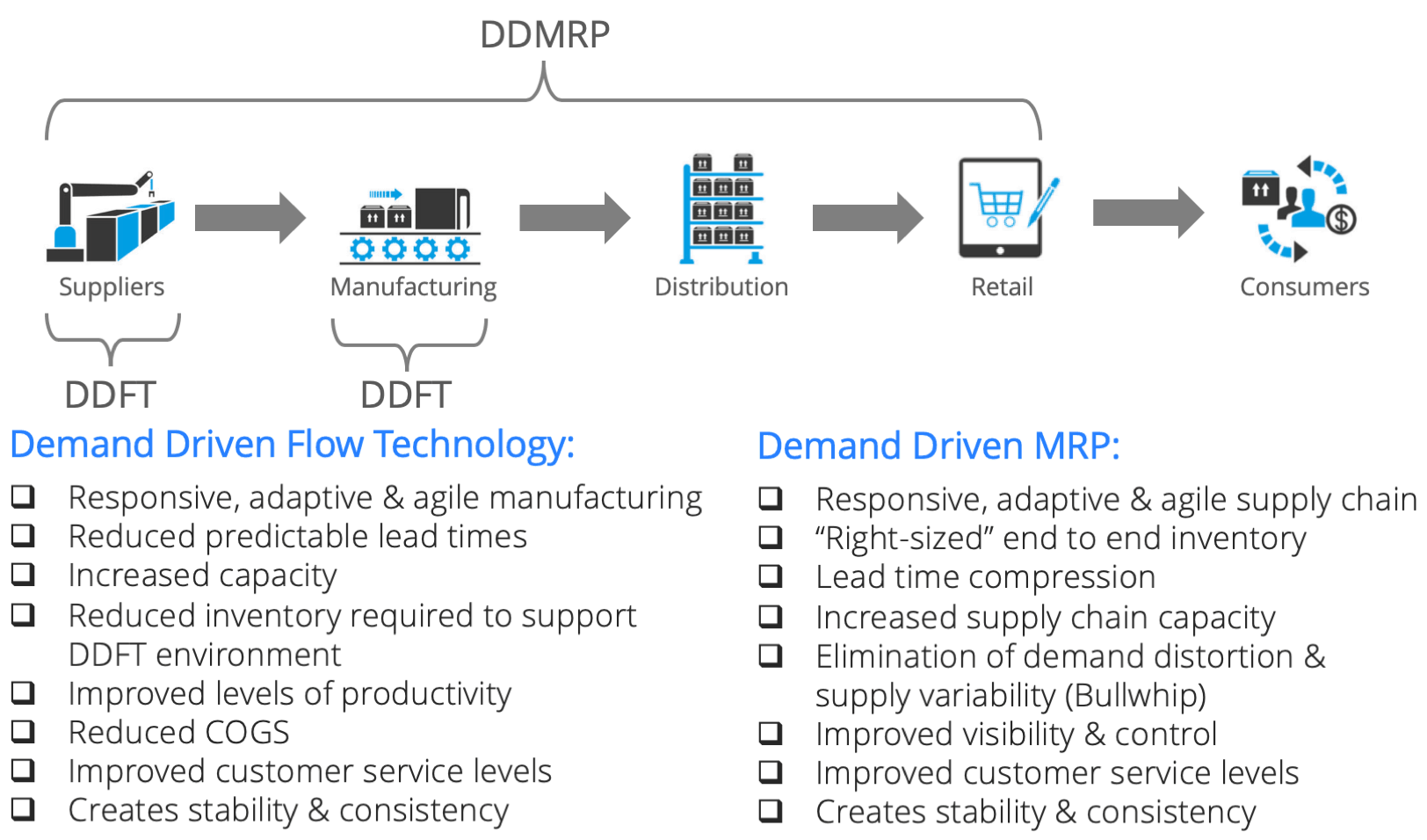Demand Driven MRP (DDMRP) and Demand Driven Flow Technology are Demand Driven methodologies that work together to maximize benefits of the Demand Driven Operating Model through their protocooperation symbiotic relationship.
Protocooperation Symbiosis
The sea anemone and the clownfish are an example of protocooperation symbiosis where both can survive independently of the other, and a relationship between the two will benefit both. The clownfish lives within the stinging tentacles of the anemone that protects it from its predators; in turn, the clownfish will protect the anemone from its predators and even brings it food.
Demand Driven
In simple terms, to be Demand Driven is to enable flow within the manufacturing facility and through the supply chain, diminishing supply disruption and demand distortion (the Bullwhip) such that the organization can respond to actual demand rather than a forecast.
To respond to actual demand, an organization needs to be as close as possible to the true demand signal. Therefore a Demand Driven methodology needs to reduce lead times to bring a company as close as possible to its actual demand source, the customer. Furthermore, the company needs to be responsive to actual demand requirements, as well as having the capability to adapt to changes in both demand and supply, as and when they arise.
The Demand Driven supply chain methodology, Demand Driven MRP, and the Demand Driven manufacturing methodology, Demand Driven Flow Technology, have each brought success to companies around the world. Each of these methodologies has the primary focus of creating Flow. Demand Driven MRP (DDMRP) promotes and protects the flow of products and materials through the supply chain. DDMRP, the “engine” of the Demand Driven Operating Model, enables the planning and execution of an organization’s Demand Driven supply chain to achieve a reduction in supply chain lead times, and inventory while at the same time improving service levels. Much has been written about DDMRP and the significant achievements of DDMRP with major global companies sharing their journey in various case studies at the Demand Driven Institute and at Demand Driven World 2019.
Let’s move focus to Demand Driven Flow Technology (DDFT) and how it transforms manufacturing companies. DDFT is fully aligned with DDMRP and it will also generate benefits within the Demand Driven Operating Model. Demand Driven Flow Technology achieves this through the design and deployment of a productive, synchronized and balanced mixed-model product flow within the manufacturing facility. Subsequent benefits are attained during the daily operation of this new manufacturing environment with DDFT policies controlling the actions, behaviour and responsiveness of the manufacturing resources to minimize lead time and work-in-process as manufacturing orders now rapidly flow through the facility.
So, What is Demand Driven Flow Technology?
Demand Driven Flow Technology is a scalable and comprehensive mathematically-based Demand Driven manufacturing strategy designed to drive high levels of response capability, compress manufacturing lead times, improve productivity and reduce operational costs enabling manufacturers to become more profitable and effective in meeting the needs of their customers. DDFT achieves this by enabling reduced, repeatable manufacturing lead times for all products through the creation of synchronized mixed-model balanced flow to create an optimized manufacturing environment that is responsive to changes in demand.
With increased velocity and more responsive facilities, DDFT transforms manufacturing organizations empowering them to gain control of previously out of balance factories that suffered from long lead times, high levels of work-in-process inventories, low customer service levels and spiralling operational costs. Through the implementation of DDFT, manufacturing organizations around the world have achieved tangible benefits that drive sustainable bottom-line results that would please any CFO. Benefits of 70+% lead time reduction, 66% capacity improvement, 69% productivity improvement, and 25% COGS improvement can and have been achieved throughout various industry sectors. One important point to note, after achieving such significant benefits, our clients continue to improve and redesign to sustain the benefits as the business landscape changes. Failure to adapt, continually improve will result in failure to meet the needs of customers.
Enablers of Flow in The Supply Chain
The following graphic illustrates the reach within the end-to-end supply chain that both methodologies have and their alignment with each other to improve the Demand Driven Operating Model.
The Demand Driven, Protocooperation Symbiotic, Relationship
Neither Demand Driven MRP or Demand Driven Flow Technology requires the other to be in place to function, with each methodology independently delivering significant benefits for an organization. The integration of both methodologies will provide a quantum leap for any organization through the consolidation of benefits achieved from operating each methodology. In addition to these consolidated benefits, integration of these methodologies within the Demand Driven Operating Model will ensure that the improvements from each methodology will promote secondary improvements from the other.
Through the reduction of lead times in manufacture, DDFT will enable the DDMRP model to reduce buffers, promote further compression of supply chain lead times and further savings in average inventory and order quantities. Lead time reduction through a DDFT facility transformation project is so significant, that the Buffer profiles within the DDMRP model configuration will need to be reassessed. Furthermore, the strategic positioning of decoupling points within the DDMRP model will most likely need to be reviewed. This can potentially enable Finished Goods buffers to be removed or the decoupling points repositioned upstream as the factory now has the capability to produce and supply products in less time than the marketplace requires. This subsequently promotes potential business growth opportunities through premium pricing for shorter order lead times and/or increased market share generated by offering lead times shorter than the competition.
Demand Driven Flow Technology will also minimize the variability in product lead time through the factory thereby reducing the level of supply variation feeding into a DDMRP buffer further reducing average inventory. The improved consistency of lead times, increased levels of capacity and the ability to run a greater mix of products on a daily basis will boost further benefits through DDMRP and the overall Demand Driven Operating Model.

Manufacturing companies that are already running Demand Driven Flow Technology will also benefit from the adoption of DDMRP. With DDMRP Planning using actual demand to determine supply order requirements, orders released to the shop floor would be for those products that are required rather than what is thought will be required based on an inaccurate sales forecast. Consequently, production capacity and machine utilization levels will be greatly improved.
Improved material availability generated from running DDMRP will drive the further reduction in manufacturing lead times as well as reducing the variability in lead time. These secondary benefits achieved in the manufacturing facility, in turn, will then promote further DDMRP improvements.

Summary
Demand Driven MRP and Demand Driven Flow Technology have a mutually beneficial and aligned relationship that generates enhanced benefits for any organization. Together both methodologies work to maximize the benefits within the Demand Driven Operating Model reducing inventory, lead times and costs while improving customer service levels, ROI and cash-flow. The impact of each methodology to an organization is significant, so the result of operating both methodologies together will further aid in the transformation of a business into becoming a world-class Demand Driven organization at the forefront of its industry.
Are you interested in getting more information on how your company can be dramatically transformed maximizing the benefits of a Demand Driven Operation Model with Demand Driven MRP and Demand Driven Flow Technology? Contact us now to discuss how we can help transform your manufacturing flow with DDFT or how we can help reduce your inventory levels and improve service levels with DDMRP.
With DDMRP and DDFT you can join a worldwide community who are significantly reducing their working capital, lead times and improving their position in the marketplace, both from a sales and financial perspective.
Further Information
Overview of High Impacts’ demand driven strategies that will transform your factories and supply chain network:
Previous High Impact Insights:
- What is Demand Driven Flow Technology
- Demand Driven Flow Technology Tools
- Demand Driven Flow Technology Benefits – Review of an Implementation
- What is DDMRP?
- MRP – Solution or Problem
- Adapt or Die – Become Demand Driven
- Supply Chain Brain: DDMRP as an Emerging Disruptive Supply Chain Capability
- What Does VUCA Mean?
LinkedIn Information:
Talk to us today to learn more about how we can help your organization become Demand Driven through adoption of our Demand Driven methodologies, DDMRP and Demand Driven Flow Technology.
Newsletter Sign-Up
Keep up-to-date on with what’s happening in our Demand Driven World. Get information manufacturing and supply chain topics as well as news on client achievements, up and coming training events and other interesting stuff!






